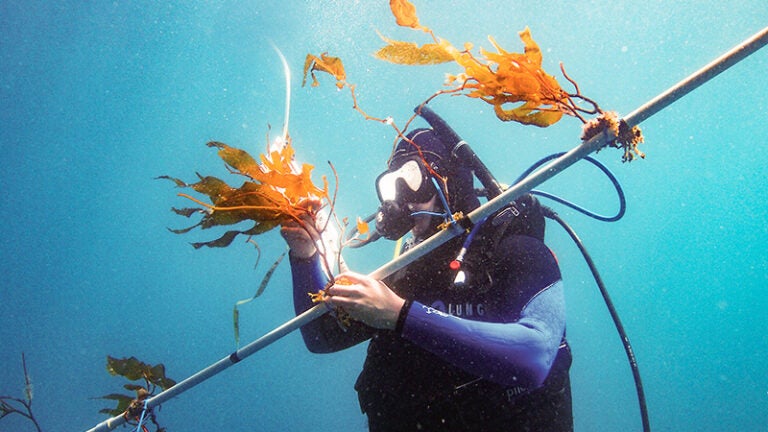
‘Kelp elevator’ study shows promise for producing biofuel from giant seaweed
Biofuels that power cars, jet airplanes, ships and big trucks come primarily from corn and other mass-produced farm crops. But researchers at the USC Wrigley Institute for Environmental Studies, headquartered at USC Dornsife College of Letters, Arts and Sciences, have looked to the ocean for what could be an even better biofuel crop: seaweed.
Scientists at the USC Wrigley Institute report that a new aquaculture technique dramatically increases kelp growth, yielding four times more biomass than natural processes. The technique employs a contraption called the “kelp elevator,” which enhances growth of the seaweed by raising and lowering it to different depths to optimize sunlight exposure and nutrient supply.
The team’s newly published findings suggest it may be possible to use the open ocean to grow kelp crops for low-carbon biofuel similar to how land is used to harvest fuel feedstocks such as corn and sugarcane — and with potentially fewer adverse environmental impacts.
“Forging new pathways to make biofuel requires proving that new methods and feedstocks work. This experiment … demonstrates kelp can be managed to maximize growth,” said the study’s corresponding author Diane Young Kim at the USC Wrigley Institute and a professor of environmental studies at USC Dornsife.
The study was published on Feb. 19 in the journal Renewable and Sustainable Energy Reviews. The authors include researchers from USC Dornsife and the La Cañada, California-based company Marine BioEnergy Inc., which designed and built the experimental system for the study and is currently designing the technology for open-ocean kelp farms.
Kelp shows serious promise as biofuel crop
If it lives up to its potential, kelp is a more attractive option than the usual biofuel crops — corn, canola, soybeans and switchgrass. For one, ocean crops do not compete for fresh water, agricultural land or artificial fertilizers. And second, ocean farming does not threaten important habitats when marginal land is brought into cultivation.
The scientists focused on giant kelp, Macrocystis pyrifera, one of nature’s fastest-growing plants.
But farming kelp requires overcoming a few obstacles. To thrive, kelp has to be anchored to a substrate and only grows in sun-soaked waters to about 60 feet deep. But in open oceans, the sunlit surface layer lacks nutrients available in deeper water.
To maximize growth in this ecosystem, the scientists had to figure out how to give kelp a foothold to hang onto, lots of sunlight and access to abundant nutrients. And they had to see if kelp could survive deeper below the surface. So, Marine BioEnergy invented the concept of depth-cycling the kelp, and USC Wrigley Institute scientists conducted the biological and oceanographic trial.
The kelp elevator consists of fiberglass tubes and stainless-steel cables that support the kelp in the open ocean. Juvenile kelp is affixed to a horizontal beam, and the entire structure is raised and lowered in the water using an automated winch.
Beginning in 2019, research divers collected kelp from the wild, affixed it to the kelp elevator and then deployed it off the shore of California’s Catalina Island, near the USC Wrigley Institute’s marine field station. Every day for about 100 days, the elevator raised the kelp near to the surface during the day so it could soak up sunlight, then lowered it about 260 feet at night so it could absorb nutrients in the deeper water.
“We found that depth-cycled kelp grew much faster than the control group of kelp, producing four times the biomass production,” Kim said.
The push to develop a new generation of biofuels
Prior to the experiment, it was unclear whether kelp could effectively absorb the nutrients in the deep. The study suggests that the kelp found all it needed to thrive when lowered into deep water at night. Equally important, the kelp was able to withstand the greater underwater pressure.
“The good news is the farm system can be assembled from off-the-shelf products without new technology,” said Brian Wilcox, co-founder and chief engineer of Marine BioEnergy. “Once implemented, depth-cycling farms could lead to a new way to produce affordable, carbon-neutral fuel year-round.”
Cindy Wilcox, co-founder and president of Marine BioEnergy, estimates that it would take a Utah-sized patch of ocean — equal to just 0.13% of the Pacific Ocean — to make enough kelp biofuel to replace 10% of the liquid petroleum consumed annually in the United States.